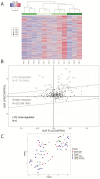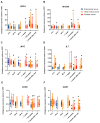Transcriptional Inflammatory Signature in Healthy Donors and Different Radiotherapy Cancer Patients
- PMID: 38256152
- PMCID: PMC10816540
- DOI: 10.3390/ijms25021080
Transcriptional Inflammatory Signature in Healthy Donors and Different Radiotherapy Cancer Patients
Abstract
Cancer and ionizing radiation exposure are associated with inflammation. To identify a set of radiation-specific signatures of inflammation-associated genes in the blood of partially exposed radiotherapy patients, differential expression of 249 inflammatory genes was analyzed in blood samples from cancer patients and healthy individuals. The gene expression analysis on a cohort of 63 cancer patients (endometrial, head and neck, and prostate cancer) before and during radiotherapy (24 h, 48 h, ~1 week, ~4-8 weeks, and 1 month after the last fraction) identified 31 genes and 15 up- and 16 down-regulated genes. Transcription variability under normal conditions was determined using blood drawn on three separate occasions from four healthy donors. No difference in inflammatory expression between healthy donors and cancer patients could be detected prior to radiotherapy. Remarkably, repeated sampling of healthy donors revealed an individual endogenous inflammatory signature. Next, the potential confounding effect of concomitant inflammation was studied in the blood of seven healthy donors taken before and 24 h after a flu vaccine or ex vivo LPS (lipopolysaccharide) treatment; flu vaccination was not detected at the transcriptional level and LPS did not have any effect on the radiation-induced signature identified. Finally, we identified a radiation-specific signature of 31 genes in the blood of radiotherapy patients that were common for all cancers, regardless of the immune status of patients. Confirmation via MQRT-PCR was obtained for BCL6, MYD88, MYC, IL7, CCR4 and CCR7. This study offers the foundation for future research on biomarkers of radiation exposure, radiation sensitivity, and radiation toxicity for personalized radiotherapy treatment.
Keywords: biomarkers; cancer patients; gene expression; human blood; inflammation; radiotherapy.
Conflict of interest statement
The authors declare no conflicts of interest.
Figures





Similar articles
-
Radiotherapy-Associated Long-term Modification of Expression of the Inflammatory Biomarker Genes ARG1, BCL2L1, and MYC.Front Immunol. 2017 Apr 10;8:412. doi: 10.3389/fimmu.2017.00412. eCollection 2017. Front Immunol. 2017. PMID: 28443095 Free PMC article.
-
An ionising radiation-induced specific transcriptional signature of inflammation-associated genes in whole blood from radiotherapy patients: a pilot study.Radiat Oncol. 2021 May 3;16(1):83. doi: 10.1186/s13014-021-01807-4. Radiat Oncol. 2021. PMID: 33941218 Free PMC article.
-
Serum Proteome Signature of Radiation Response: Upregulation of Inflammation-Related Factors and Downregulation of Apolipoproteins and Coagulation Factors in Cancer Patients Treated With Radiation Therapy--A Pilot Study.Int J Radiat Oncol Biol Phys. 2015 Aug 1;92(5):1108-1115. doi: 10.1016/j.ijrobp.2015.03.040. Epub 2015 Apr 7. Int J Radiat Oncol Biol Phys. 2015. PMID: 26031365
-
Systemic effects of ionizing radiation at the proteome and metabolome levels in the blood of cancer patients treated with radiotherapy: the influence of inflammation and radiation toxicity.Int J Radiat Biol. 2017 Jul;93(7):683-696. doi: 10.1080/09553002.2017.1304590. Epub 2017 Mar 30. Int J Radiat Biol. 2017. PMID: 28281355 Review.
-
Radiation-induced hypothyroidism after treatment of head and neck cancer.Dan Med J. 2016 Mar;63(3):B5213. Dan Med J. 2016. PMID: 26931197 Review.
Cited by
-
Genome-wide transcriptomic response of whole blood to radiation.Sci Rep. 2025 Jun 5;15(1):19840. doi: 10.1038/s41598-025-04898-1. Sci Rep. 2025. PMID: 40473848 Free PMC article.
References
-
- Kabacik S., Mackay A., Tamber N., Manning G., Finnon P., Paillier F., Ashworth A., Bouffler S., Badie C. Gene expression following ionising radiation: Identification of biomarkers for dose estimation and prediction of individual response. Int. J. Radiat. Biol. 2011;87:115–129. doi: 10.3109/09553002.2010.519424. - DOI - PubMed
-
- El-Saghire H., Thierens H., Monsieurs P., Michaux A., Vandevoorde C., Baatout S. Gene set enrichment analysis highlights different gene expression profiles in whole blood samples X-irradiated with low and high doses. Int. J. Radiat. Biol. 2013;89:628–638. doi: 10.3109/09553002.2013.782448. - DOI - PubMed
MeSH terms
Substances
Grants and funding
LinkOut - more resources
Full Text Sources
Medical

